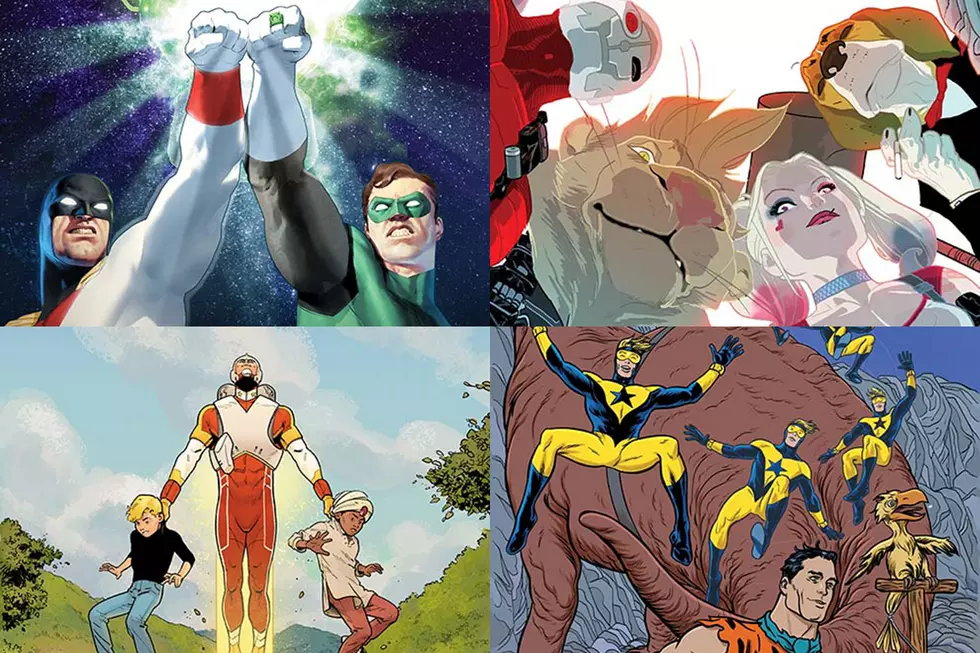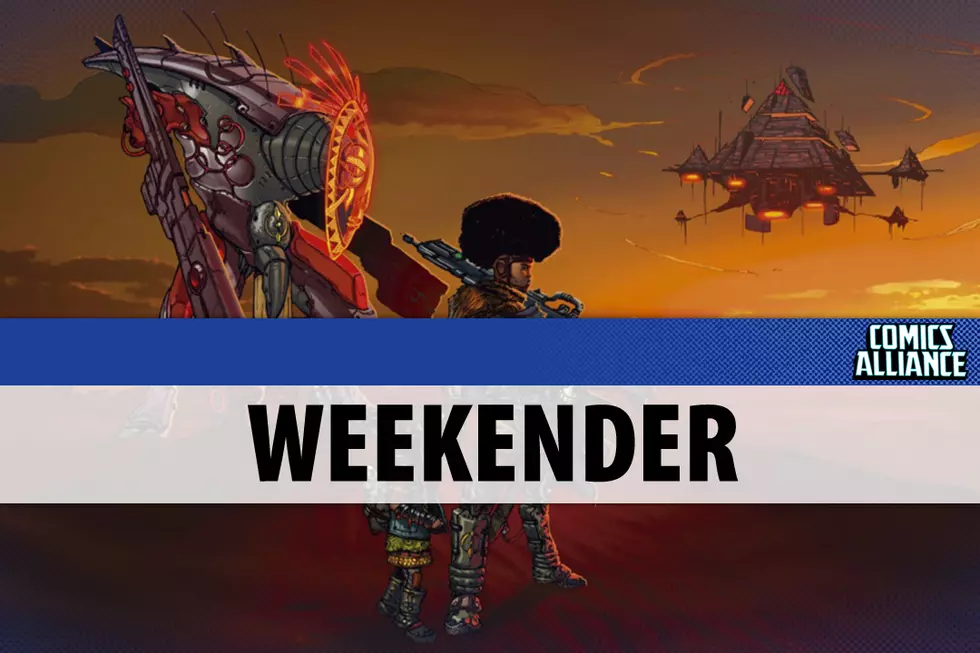![Two Very Good Reasons To Read ‘Alabaster: Wolves’ #1 [Preview]](http://townsquare.media/site/622/files/2012/04/stevelieber-alabasterwolves-01-top.jpg?w=980&q=75)
Two Very Good Reasons To Read ‘Alabaster: Wolves’ #1 [Preview]

What makes you want to read a comic? Usually people would just say "I like the writing and art" and leave it at that, but it's never that simple. We're always drawn to something specific even if we can't articulate it, like how so-and-so draws muscles or how what's-his-name tells jokes. These things are always personal to us, and sometimes they're hard to explain. I recently read Caitlín R. Kiernan, Steve Lieber, and Rachelle Rosenberg's Alabaster: Wolves #1 -- available in stores from Dark Horse Comics this Wednesday -- and I've got two reasons why you should read that comic this week: the countrified dialogue and the alchemy between the writing, pencils and inks, and colors.Alabaster: Wolves is the story of the trials and travails of Dancy Flammarion, a sixteen-year-old monster hunter with a guardian angel by her side. She's been tasked with killing monsters by Heaven, essentially, whether she wants to or not. Your first thought might be that she's another Hellboy or Buffy, but you'd be wrong. She's no expert, just a girl thrown into a bad situation, getting by as best she can. She's a scrapper, rather than an expert. The first issue of Alabaster: Wolves takes place in the middle of nowhere -- South Carolina -- and sets the stage for the conflict to come.
I'm from the south. Georgia, to be specific, though you wouldn't know it to talk to me. My folks are from Ohio, and I've lived elsewhere enough to miss out on the accent. I've still got country grammar, though, and I twang when I get excited, so it's nice (but rare) to see southern cadence and dialect in comics that don't involve a bunch of "sugah"s and phonetic spellings. Garth Ennis is probably the best writer at it right now, but Mike Carey had a perfectly cornpone Sam Guthrie when he was writing X-Men with Chris Bachalo and Humberto Ramos on art. When these accents are conveyed convincingly, and without all the Chris Claremont-ian phonetic tomfoolery, it greatly increases my enjoyment of a book.

There's a rhythm and certain je ne sais quoi to the sentence structure and implied rhythm of southern dialogue, an elegant compression and expansion of certain vowels and sounds, that's not like anything else. It's bigger than just throwing around "y'all" willy-nilly, or dropping the "g" off words ending in -ing. It's about recognizing the difference between "I reckon" and "Reckon so," and being able to use ain't in a sentence the proper way. It's about knowing when to use "you," "ya," "yew," and "yuh." There's a casual and easygoing manner to southern speech, like you've got all the time in the world and there's a pleasure in sitting around and conversating with somebody else.
That's one reason why it's so nice to read Alabaster: Wolves #1: Kiernan gets it. Dancy Flammarion, star of Alabaster: Wolves, is a country girl, and the first issue is largely composed of a conversation that conveys the twang and cadence of southern conversation with nary a "sugah" to be found. Kiernan's dialogue has a pace, a cadence that's almost musical, and it makes me believe that Dancy's from the south, just like I believe that the setting is South Carolina, home of ComicsAlliance's other southern gentleman, Chris Sims.

Shifting gears: One of the nicest things about collaborative comics, rather than comics created by a single cartoonist, is seeing how the members of that team play off each other. Frank Miller and Klaus Janson are a great example, as their classic run on Daredevil blurred the lines between who was doing what by the end. In some cases, the members of the team work against each other and the book becomes a tonal mess. In the best comics, also known as the only comics you should ever read, every member of the team brings something great to the table.
I've talked about Kiernan's dialogue. It's rounded and warm in all the right ways. She doesn't use the caption boxes to explain the action happening on the page, either. She trusts the storytelling abilities of the artists on the book, and therefore gets out of their way when it comes to rendering action. This is a good thing, because Steve Lieber and Rachelle Rosenberg are the art team, with Lieber on pencils and inks and Rosenberg on colors, and they're more than capable of getting the job done in incredible ways.
Alabaster: Wolves is, in a lot of ways, a horror comic. Rosenberg uses a lot of black, but her palette for the backgrounds tend to run toward greens and blues. Dancy is walking around an area that feels grungy, like an emptied out swimming pool or a musty old barn. It feels moldy and old, which is a pretty perfect mood for a horror comic. We've all seen dark houses and empty streets before, where the shadows hold hidden dangers and black is the most dangerous color around. Here, Rosenberg's palette is foggy, and instead of threats jumping out from dark windows, they appear out of thin air.

And then, when things start getting serious, Rosenberg brings in faded blacks and burning oranges laced with white. There's a sharp contrast in mood there, and the entire comic turns at that moment. The fiery lighting highlights the characters, even though only one character can see the source of the light. The new light battles with the greens and blues, and certain panels fade from one to the other, increasing the sense of conflict in the book.
Lieber, too, is doing great things with his art. A certain character, a werewolf, to be specific, has dirty feet. It's a little nothing touch, something you wouldn't notice unless you were looking for it, but think it through. The werewolf has dirty feet because she walks everywhere. You can extrapolate from there. She probably lives outside, rather than in a house, and doesn't bother to shower. There's a lack of personal hygiene there, and that's characterization all its own.

Or check out Dancy's body language in the preview. She goes from open and smiling when she meets the bird to sullen and confrontational when the bird calls her crazy. She's sensitive about that. Later, she's distracted, and finally, bored. Then she goes from relaxed to protective when the werewolf shows up, and then defensive when the werewolf says Dancy smells bad. Look at how she's sitting on that bench. She's as far as she can get from the werewolf, and then turned to the side for even more distance.
Lieber and Rosenberg together are nuts. There's a single page late in the book where Dancy is standing in front of a sheet of orange, tears streaming down her face, both hands clasped together and streaked with red. It's a killer image, the sort of thing I'll never get enough of. It's gentle and horrific and apocalyptic all at once.
Good writing. Good pencil and ink work. Good colors. That's a good comic. It comes out Wednesday in comic shop and on Dark Horse Digital.








More From ComicsAlliance



![The Poet Of The Lost: Rediscovering Caitlin R. Kiernan [Fantasy Week]](http://townsquare.media/site/622/files/2016/10/drowninggirl-feat.jpg?w=980&q=75)

![The World’s Worst Superheroes Are In For A Bad Time In ‘Quantum And Woody Must Die’ #1 [Preview]](http://townsquare.media/site/622/files/2015/01/Quantum00.jpg?w=980&q=75)



